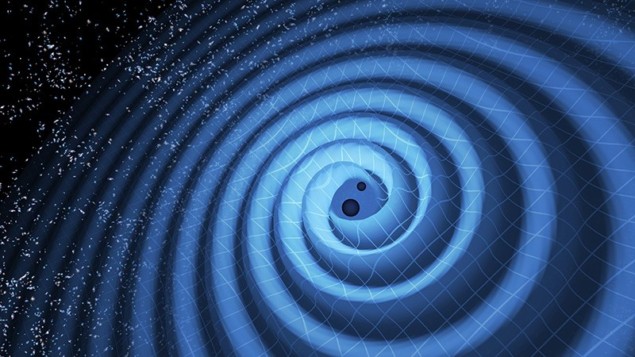
Evidence for a new type of subatomic particle could be lurking within the gravitational waves produced by some merging black holes, according to calculations by physicists in the US and the Netherlands. John Stout at Harvard University and colleagues have studied a process whereby a cloud of hypothetical ultralight bosons could form around a black hole, creating a “gravitational atom”. They reckon that if such a black hole were in a merging binary pair, the presence of the ultralight bosons would be revealed by “kinks” frequencies of the emitted gravitational waves.
Gravitational waves produced by merging pairs of black holes were first observed in 2015 by the LIGO observatories and since then many more signals have been spotted. The theory of gravitational-wave production is robust, so any deviations between theory and observation could point to new physics beyond the Standard Model of particle physics.
For example, deviations could be caused by the existence of ultralight bosons, which are not part of the Standard Model. These are hypothetical particles with extremely low masses that would couple extremely weakly to regular matter. Ultralight bosons are believed by some to be promising candidates for dark matter, but according to current theories, they are not necessarily abundant throughout the universe – making them particularly challenging to detect.
Black hole superradiance
Stout and colleagues believe that evidence for ultralight bosons could be revealed by an effect called black hole superradiance. In this hypothetical scenario the number of ultralight bosons surrounding a black hole is amplified by the black hole’s rapid rotation. This would create a cloud of ultralight bosons surrounding the black hole in which the particles would occupy specific orbits, much like the electron clouds surrounding atomic nuclei.
In their study, Stout’s team explored a scenario where one black hole in a binary pair is such a gravity atom. As the black holes orbit each other, the cloud of ultralight bosons would experience a periodic perturbations from the gravitational field of the other black hole – and as the black holes spiral towards each other, the frequency of the perturbation would increase.
Fleeing bosons
At first these perturbations would cause transitions within the cloud, promoting ultralight bosons to higher-energy orbits. However, as the frequency increases, particles would start to be ejected from the clouds – in a process like atomic ionization. These ejected particles would carry energy away from the black-hole system. Stout and colleagues reckon that this energy loss could happen suddenly and surpass the energy lost by the binary pair to gravitational waves. As a result, the effect of the fleeing superlight bosons would be imprinted within the gravitational-wave signal from the black-hole pair.

Gravitational waves could reveal ultralight bosons lurking near black holes
They have calculated that this ionization would cause kinks in frequency evolution of gravitational waves emitted by the black-hole binary. If detected in real gravitational wave signals, this would not only provide a unique signature of the ultralight boson cloud, it would also contain direct information about its mass and energy states.
Unfortunately, these kinks cannot be observed by current gravitational-wave detectors such as LIGO and Virgo. However, the team predicts that the signature could be easily detected by the upcoming LISA space observatory, now scheduled for launch in 2037.
The research is described in Physical Review Letters.



